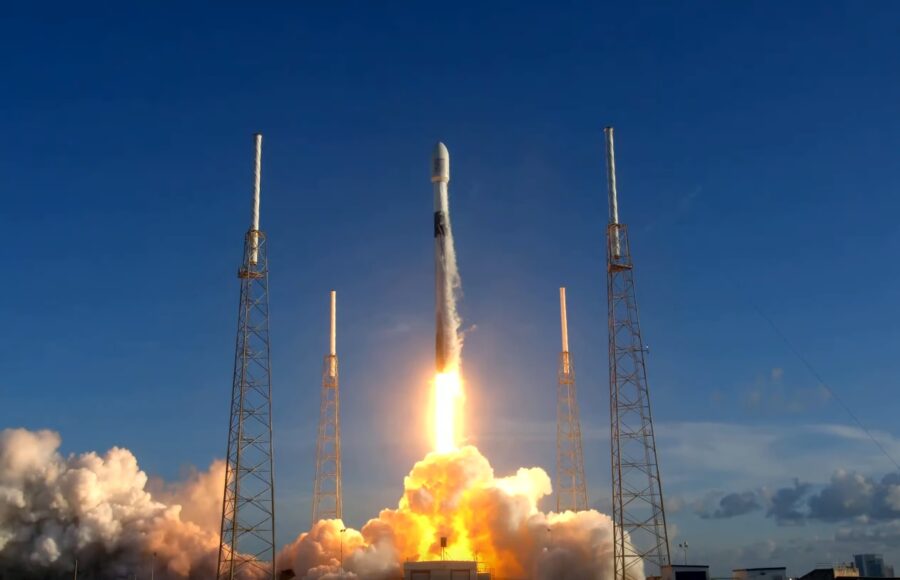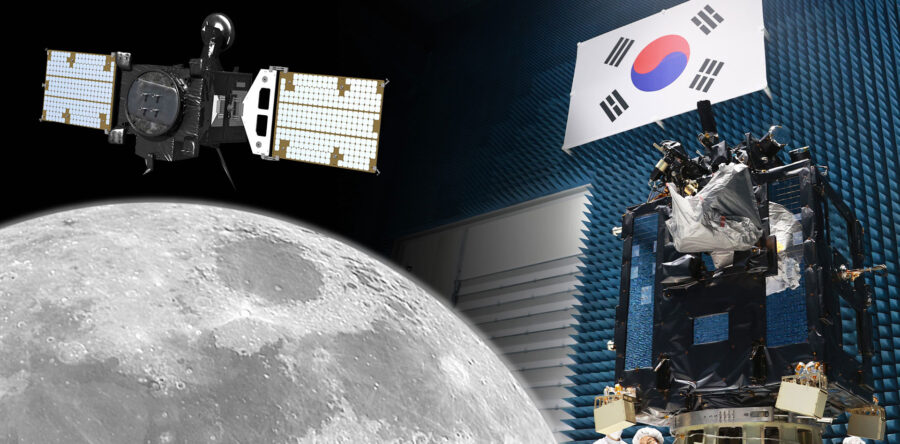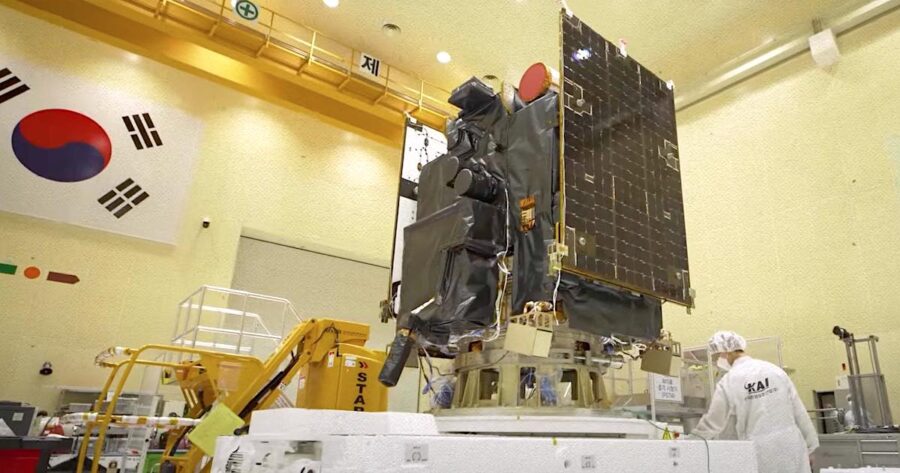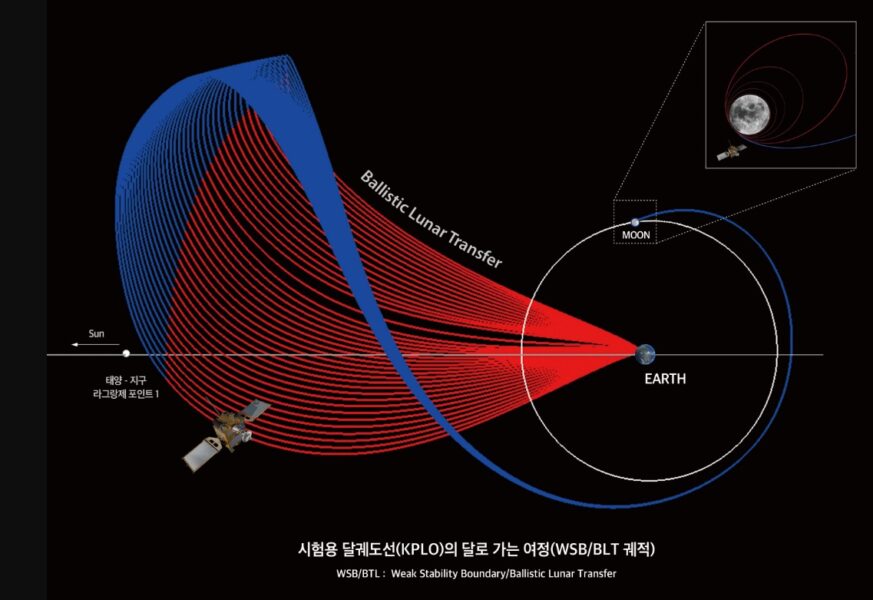South Korea’s lunar orbiter has launched successfully for the Moon, joining a growing number of missions there.

SpaceX
A SpaceX Falcon 9 rocket lit up the skies over Cape Canaveral in Florida yesterday evening, taking with it South Korea’s first Moon mission: the Korea Pathfinder Lunar Orbiter, now officially called Danuri. The $180 million mission is a pathfinder for an eventual mission with an orbiter, lander, and rover.
Liftoff occurred at 7:08 p.m. EDT / 11:08 p.m. UT. The Falcon 9 first stage booster returned to Earth for future use, landing on a drone ship off the Florida coast. The upper-stage separation and spacecraft deployment all went off as planned, and mission controllers report that Danuri is in good health.
The mission entered a preliminary 29° inclination orbit at an altitude of 155 miles (250 kilometers) until a second burn placed the spacecraft in a lunar transfer orbit. The launch is the second lunar mission of the year to leave Earth, behind the Capstone CubeSat launched by Rocket Lab last month.
What Danuri Will Deliver

KARI
The mission's name, Danuri, is a portmanteau of the Korean words dal and nurida, collectively meaning “enjoy the Moon.” The mission will scout the lunar surface for minerals and elements, including aluminum, helium-3, and surface water ice.
To accomplish this, the solar-powered spacecraft carries six instruments, one from NASA and five from the Korea Aerospace Research Institute (KARI):
- The Wide-Angle Polarimetric Camera (PolCam) will image and analyze the lunar regolith in polarized light. Though Earth-observing satellites have long used this technique, this is the first time a polarized-light imager has flown to the Moon. Bill Farrand (Space Science Institute) says that he will use PolCam to explore the nature of pyroclastic deposits, which formed early in the Moon's history during explosive volcanic activity.
- The KPLO Magnetometer contains three sensors that will characterize the magnetic field lines frozen into lunar rocks.
- The Lunar Terrain Imager will take sharp images of future landing sites, resolving features down to just 16.5 feet (5 meters) across.
- The Delay-Tolerant Networking experiment will test a sort of “interplanetary internet” by addressing the technical issues that arise in a communications network that lacks continuous connectivity.
- The Gamma Ray Spectrometer is a gamma-ray spectrometer that works in the 10 kilo-electron volt (keV) to 10 mega-electron volt (MeV) range to probe the surface of the Moon in search of key chemicals and elements.
- The sole NASA instrument, ShadowCam, will hunt for lunar water ice in permanently shadowed regions of the Moon. ShadowCam is 800 times more sensitive than a similar camera on the Lunar Reconnaissance Orbiter.
International Collaboration

KARI
KARI operates KPLO and built the spacecraft in partnership with NASA and other U.S. institutions. The newly installed Korea Deep Space Antenna in Yeoju, South Korea, will also help track Danuri, along with global coverage provided by NASA’s Deep Space Network.
KARI and NASA have been working together on the mission since 2016. “From the beginning of (the) KPLO mission, KARI and NASA talked and discussed in-depth to find a cooperative way for the two space agencies,” says Eunhyeuk Kim (KARI).
Path to the Moon

KARI
Now, KPLO will take a slow, looping Ballistic Lunar Transfer (BLT) orbit en route to the Moon. “[The spacecraft] will take a so-called ‘low-energy transfer orbit’ or ‘weak stability boundary orbit,’” says Sungsoo Kim (KARI). This path will take it towards the L1 Lagrange point, 1.5 million kilometers from Earth in the sunward direction, before the spacecraft enters a capture orbit around the Moon on December 16th. On December 31st, it will enter a circular orbit at 100 km . NASA's recently launched Capstone mission is taking a similar low-energy path to the Moon.
Danuri will start one year of science operations in early 2023. If the mission performs well, Kim says, an extended science phase could take it into an elliptical orbit that would have it skimming just 20 kilometers over the lunar surface.
Interplanetary Ambitions
KARI is a signatory to the Artemis Accords, meaning South Korea could potentially contribute to the common human effort to explore the Moon. KARI first put South Korea in the world spaceflight community in 2013, when its Naro 1 rocket successfully reached low-Earth orbit.
Naro 1 used a Russian-made first stage, and the war in Ukraine raised concerns that international sanctions on Russia would spell the end for South Korea’s nascent spaceflight program. But KARI rebounded with the three-stage Nuri rocket, developed entirely in South Korea. The successor to Naro, Nuri has been under development since 2010 and successfully launched five satellites into orbit on June 21, 2022.
An improved version of the Nuri rocket is expected to launch a proposed lunar lander mission around 2030.
Moon Missions to Watch
There are still more Moon missions to come. We may finally see NASA’s Artemis 1 leave Earth at the end of this month (no earlier than August 29th). Also watch for the first two Commercial Lunar Payload Services missions — Astrobotics’ Peregrine Lander and Intuitive Machines’ Nova C lander — later this year or early next.
Congrats to KARI and South Korea on their first lunar mission, as humankind returns to the Moon.
 2
2









Comments
Warren-Odom
August 7, 2022 at 5:40 pm
"On December 31st, it will enter a circular orbit at 100 km on December 31st."
You might want to delete the redundancy.
You must be logged in to post a comment.
Monica Young
August 12, 2022 at 10:14 am
Done, thanks!
You must be logged in to post a comment.
You must be logged in to post a comment.